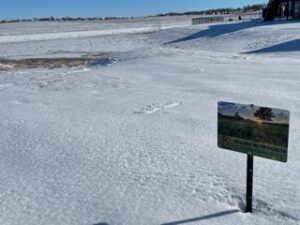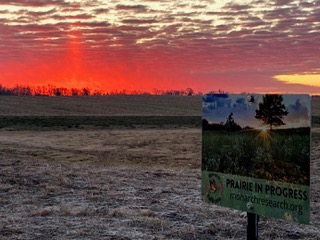 When Lonnie Smith started thinking about establishing an area behind his new home in native habitat, he sought out the resources of the Monarch Research Project. With the offer of 400sf of highly diverse native pollinator seed for free from MRP, augmented with a separate purchase from Ion Exchange in Harper’s Ferry, IA; Lonnie was able to begin the work necessary to get his 6500sf area seeded.
When Lonnie Smith started thinking about establishing an area behind his new home in native habitat, he sought out the resources of the Monarch Research Project. With the offer of 400sf of highly diverse native pollinator seed for free from MRP, augmented with a separate purchase from Ion Exchange in Harper’s Ferry, IA; Lonnie was able to begin the work necessary to get his 6500sf area seeded.
With advice from Monarch Research Project’s own Mike Martin, as well as from volunteer Jim Hoffman, Lonnie further sought out tips from David Novak, owner of Prairie Oaks Restoration – one of the leading prairie establishment and maintenance companies in the area. David was extremely helpful, recommending Lonnie purchase several seed blankets to cover a couple steep sloped areas, to hold the seed, reducing erosion.
This past summer, after carefully spraying the area twice to remove existing weeds and vegetation, Lonnie acquired the seed for planting. Mixing the seed, with generous portions of sand, Lonnie was able to cover the entire area in two directions, including the steep slopes. Knowing how important it was to properly install the seed blankets, David helped to install each just before a snowfall in December of 2020.
As you can see from the photos below, the site is now covered with snow, a beneficial process for many native seeds requiring cold-moist stratification. Patience is a virtue, so while Lonnie will see green next spring, he knows it will mostly be annual weeds.

Several mowings over this next summer, at a height of 4-6 inches, will keep the weeds down, allowing the native seeds to start to build their all-important root systems. Year two will see a few species start to appear and year three will be when the neighbors start to ask – how did you do that?
Way to go, Lonnie, nice job! Thank you for your hard work and patience. By installing the Monarch Research Project ‘Prairie in Progress’ sign, you are letting your neighbors know your NEW native pollinator habitat is in and beginning to get established!
For more information on how you too can help make a difference, go to the Pollinator Zone tab on this website.

